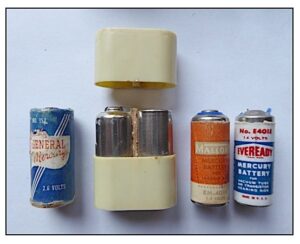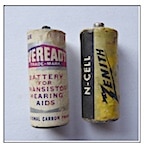The transition from vacuum tube to transistor hearing aids occurred in the mid 1950s. The transistor allowed for a single power supply, and voltage as low as 1.4.
Being able to operate on 1.4 volts reduced tremendously the power requirements, both in size and required voltage from that required for vacuum tube hearing aids. Essentially all hearing aids made this transition during this period. Two, from the same company, that served as examples of how a smaller- sized power supply was used were the Zenith Model 75-X and the Zenith Regent (Figure 1). Both used a 1.4 volt 401 battery; the Model 75-X using a single battery, and the Model Regent using two 401 batteries.
Zenith 75-X (1954)
The Zenith “75-X” used a Zenith “N” size 1.4 volt. This was Zenith’s label for the 401 battery. The hearing aid was a 3-transistor amplifier housed in a chrome case (some say polished aluminum). It measured 65 x 45 x 18 mm. It used a single 401 battery. The hearing aid was manufactured by what was then a Division of Zenith Radio Corporation, Zenith Hearing Aid Division. The reason for the model number was that the recommended cost to the consumer by Zenith was $75 – something not looked upon favorably by those selling the product.
Zenith Regent (1955)
The Zenith “Regent” transistor hearing aid was a 5-transistor aid of a push-pull (PP) amplifier type. It measured 81 x 45 x 17 mm in size, and consumer cost was designated at $195. This unit used two 401 batteries.

Figure 1. Early hearing aids that used the 401, 1.4-volt battery (Zenith N-Cell), were the Zenith “75-X” and the Zenith “Regent.” The reason for the two batteries related to the output power, with the “Regent” providing a very high output of 142 dB SPL.
Sonotone 200 Transistor Body-Worn Hearing Aid (1956)

Figure 2. Sonotone 200 4-transistor body-worn hearing aid. This was powered by a 2.8-volt battery package. The controls above the battery were, from left to right: 4-position power control, 2-position low-pass filter, and a 2-position high-pass filter. These were adjusted by the hearing aid dealer.
The Sonotone 200 was a 4-transistor push-pull hearing aid. It measured 76 x 45 x 16 mm in size (Figure 2). The hearing aid had discrete-position sliding switches, shown above the battery. The left control is a 4-position power control. The center control is a 2-position low-pass filter. The right control is a 2-position high-pass filter. The battery was a Sonotone 600 battery of 2.8 volts. This was essentially two 401 batteries in the same plastic housing, soldered together in series. This can be visualized better in Figure 3.
This post completes the series on vintage hearing aids and batteries found in the author’s garage in an old box. What was reported in this series did not attempt to provide a detailed history of development, but to highlight some of the unique features of hearing aids found in that box. In this way, the intent was to help preserve part of the history of hearing aids, especially of those in the late 1940s and through the mid 1950’s.

Figure 3. Examples of smaller batteries used with transistor hearing aids. On the left is a General mercury 2.6-volt battery. The plastic-shelled battery in the center is actually two 401 (1.4 volt) batteries soldered together to generate a series connection to provide 2.8 volts. An example of this was the Sonotone 600 battery. It generated 2.8 volts. The two batteries on the right were early 401 (1.4 volt) mercury batteries for transistor hearing aids by Mallory and Eveready.






